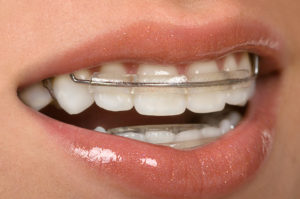
Adult braces in Norwalk are an effective way to deal with tooth and jaw misalignment problems. But wearing your retainer is just as crucial as the braces themselves. Otherwise you may lose the hard-won benefits you’ve worked so hard to attain.
Why Wearing a Retainer Is so Important
Braces are the standard treatment for malocclusion, the dental term for tooth and jaw misalignment. Left untreated, malocclusion can cause serious health issues like these:
- Tooth and gum disease. Misaligned teeth are difficult to care for. Even diligent brushing and flossing is less effective than it might otherwise be. The result: a greater chance of decay-causing bacteria wreaking havoc with your oral health.
- Headaches and TMJ. Teeth or jaw alignment problems can radiate throughout your skull and facial bones, leading to painful headaches and tension. In some cases they can even affect your neck and back, throwing off your spinal alignment.
- Damage to your teeth. Over time, tooth alignment problems can put unnatural and unhealthy stress on your teeth. This may lead to all sorts of oral health issues, including tooth loss.
Braces resolve these problems by gently realigning your teeth and your jaw muscles. But these desirable changes are less likely to “take” unless you also follow your dentist’s recommendations for wearing your retainer.
How Long Should I Wear My Retainer?
The answer depends on your oral profile and your dentist’s recommendations. Some patients need to wear the retainer full time for the first six months of therapy. Others only need to wear it full time for the first seven days followed by part-time evening sessions.
Caring for Removable Retainers
You should remove your retainer before eating, engaging in contact sports and brushing or flossing your teeth. Always keep it in the approved container. Wrapping it in tissue and setting it aside creates the risk for damage or loss.
If you’re new to wearing a retainer, then it may take a few days to get accustomed to having it in your mouth. You may experience temporary issues with eating or speaking. You may also notice elevated saliva levels for a while. These problems usually disappear in a short amount of time.
What Are Fixed Retainers?
Anyone who has ever lost or damaged a retainer knows the hassle accompanied with replacing it. One way to avoid this problem is to opt for a fixed retainer. The dentist uses dental cement to secure the product to the backside of the patient’s teeth. It’s both convenient and utterly invisible to observers. Best of all, it’s impossible to misplace.
Brushing with a fixed retainer in your mouth may take a little extra time. It’s important to clean the wire as well as the surrounding teeth to prevent plaque from building up on these surfaces. Most people who wear fixed retainers commit to using them for five years, sometimes longer. In most cases, they become so used to the product that they hardly know it’s there.
Wearing a retainer is an essential part of adult braces therapy. But the practice doesn’t have to be cumbersome or embarrassing. Ask your cosmetic dentist in Norwalk to give you additional tips at the time of your fitting. In time you’ll look back on this experience with lots of reasons to smile.
About the Author
Dr. Adam P. Sommers has been practicing dentistry since his graduation from dental school in 1999. Over that time he has completed advanced training in orthodontics and CEREC restoration therapy. You can reach his office online or by calling (419) 668-3606.


